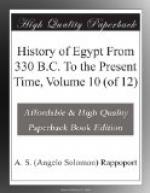Their method of drawing the human figure mathematically by means of squares, which was not unsuitable in working a statue sixty feet high, checked all flights of genius; and it afterwards destroyed Greek art, when the Greek painters were idle enough to use it. We hear but little of the statues and sculptures made for Philadelphus; but we cannot help remarking that, while the public places of Athens were filled with the statues of the great and good men who had deserved well of their country, the statues which were most common in Alexandria were those of Cline, a favourite damsel, who filled the office of cup-bearer to the king of Egypt.
The favour shown to the Jews by Ptolemy Soter was not withdrawn by his son. He even bought from his own soldiers and freed from slavery one hundred and twenty thousand men of that nation, who were scattered over Egypt. He paid for each, out of the royal treasury, one hundred and twenty drachmas, or about fifteen dollars, to those of his subjects who held them either by right of war or by purchase. In fixing the amount of the ransom, the king would seem to have been guided by his Jewish advisers, as this is exactly equal to thirty shekels, the sum fixed by the Jewish law as the price of a slave. The Jews who lived in Lower Egypt, in the enjoyment of civil and religious liberty, looked upon that country as their home. They had already a Greek translation of either the whole or some part of their sacred writings, which had been made for those whose families had been for so many generations in Egypt that they could not read the language of their forefathers. But they now hoped, by means of the king’s friendship and the weight which his wishes must carry with them, to have a Greek translation of the Bible which should bear the stamp of official authority.
Accordingly, to please them, Philadelphus sent Aris-taaus, a man whose wisdom had gained his friendship, and Andrseus, a captain of the guard, both of them Greek Jews, with costly gifts to Eleazer, the high priest of Jerusalem; and asked him to employ learned and fit men to make a Greek translation of the Bible for the library at Alexandria. Eleazer, so runs the tradition, named seventy elders to undertake the task, who held their first sitting on the business at the king’s dinner-table; when Menedemus, the Socratic philosopher, the pupil of Plato, was also present, who had been sent to Philadelphus as ambassador from Eubcea. The translators then divided the work among themselves; and when each had finished his task it wras laid before a meeting of the seventy, and then published by authority. Thus was said to have been made the Greek translation of the Old Testament, which, from the number of the translators, we now call the Septuagint; but a doubt is thrown upon the whole story by the fables which have been mingled with it to give authority to the translation. By this translation the Bible became known for the first time to the Greek philosophers. We do not indeed hear that they immediately read it or noticed it, we do not find it quoted till after the spread of Christianity; but it had a silent effect on their opinions, which we trace in the new school of Platonists soon afterwards rising in Alexandria.




